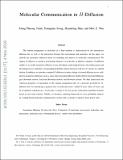Molecular Communication in H-Diffusion
Author(s)
Trinh, Dung Phuong; Jeong, Youngmin; Shin, Hyundong; Win, Moe Z
DownloadSubmitted version (652.6Kb)
Open Access Policy
Open Access Policy
Creative Commons Attribution-Noncommercial-Share Alike
Terms of use
Metadata
Show full item recordAbstract
© 1972-2012 IEEE. The random propagation of molecules in a fluid medium is characterized by the spontaneous diffusion law as well as the interaction between the environment and molecules. In this paper, we embody the anomalous diffusion theory for modeling and analysis in molecular communication. We employ H -diffusion to model a non-Fickian behavior of molecules in diffusive channels. H -diffusion enables us to model anomalous diffusion as the subordinate relationship between self-similar parent and directing processes and their corresponding probability density functions with two H -variates in a unified fashion. In addition, we introduce standard H -diffusion to make a bridge of normal diffusion across well-known anomalous diffusions such as space-time fractional diffusion, Erdélyi-Kober fractional diffusion, grey Brownian motion, fractional Brownian motion, and Brownian motion. We then characterize the statistical properties of uncertainty of the random propagation time of a molecule governed by H -diffusion laws by introducing a general class of molecular noise - called H -noise. Since H -noise can be an algebraic-tailed distribution, we provide a concept of H -noise power using finite logarithm moments based on zero-order statistics. Finally, we develop a unifying framework for error probability analysis in a timing-based molecular communication system with a concept of signal-to-noise power ratio.
Date issued
2020Department
Massachusetts Institute of Technology. Laboratory for Information and Decision SystemsJournal
IEEE Transactions on Communications
Publisher
Institute of Electrical and Electronics Engineers (IEEE)